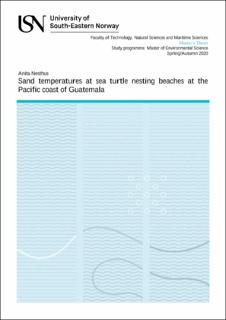| dc.description.abstract | The climate is changing, bringing extremities such as increased periods of rainfall, but also draughts and warming temperatures. There are several species with presumed little capacity to adapt to climate changes, such as species who exhibit temperature dependent sex determination (TSD). Sea turtles (Chelonioidea), along with several other reptiles (Reptilia) are one of these species. Sea turtles are long lived migratory reptiles, where all seven species (Caretta caretta, Chelonia mydas, Dermochelys coriacea, Eretmochelys imbricata, Lepidochelys kempii, Lepidochelys olivacea and Natator depressa) are either vulnerable, endangered or critically endangered. The sea turtles come ashore and nest on sandy beaches all over the world. When the temperature changes, the sex ratio and hatching success for such species with TSD is affected. In this study I measured sand temperature through 2019 at two important sea turtle nesting beaches at the Pacific coast of Guatemala, El Banco and Hawaii. Temperature recorders were placed in two transects relative to the shoreline (in exposed sand and in the vegetation belt), and at two different depths (30 and 50 cm). From the measurements I examined the effects of external factors on sand temperatures and found that environmental factors such as burial depth, type of surrounding environment at surface, precipitation, wind velocity, solar radiation and year (2018 and 2019) had an effect on the sand temperatures. Beach locality and type of transect (position relative to shoreline) did not have an effect on the sand temperature. Increased sand temperatures close to concrete constructions suggests that urban development affect the sand temperatures. I also investigated mean sand temperatures compared to pivotal temperature (i.e. the constant incubation temperature that will equally distribute both male and female turtle hatchlings) and upper lethal incubation temperatures for the three nesting sea turtles species (Dermochelys coriacea, Chelonia mydas and Lepidochelys olivacea) at the Pacific coast of Guatemala. I found that the measured mean sand temperature preceded the pivotal temperature at El Banco and Hawaii. The measured mean sand temperature did not precede the lethal incubation temperature, although some months came very close. | en_US |
